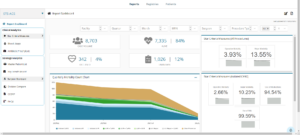A journey with Chris Hansen, head of data engineering at Q-Centrix

The ease of access and analysis of data sets can provide valuable insights into patient outcomes, operational efficiency, and financial performance. By utilizing advanced analytics tools and techniques, clinical data analytics becomes the key to unlocking the potential of healthcare data. In this blog, we join Chris Hansen, Head of Data Engineering at Q-Centrix, who led the journey into the transformative power of clinical data analytics and its impact on healthcare decision-making processes.
First, what data is used for analytics in healthcare?
Healthcare data refers to any information related to patient care and health outcomes that is collected, stored, and analyzed in the healthcare industry. This includes a wide range of data points, such as patient demographics, medical histories, diagnoses, treatments, laboratory and imaging results, medication records, billing information, patient satisfaction, and even medical supplies.
With the rise of electronic health records and other digital health technologies, healthcare data has become increasingly abundant and accessible, offering opportunities for new insights and innovations in healthcare delivery and management.
However, the same abundance that makes healthcare data so useful can also lead to an overload of information. Without proper clinical data management and effective clinical data analytics, the decision-making process that should improve care and save lives can be inhibited.
Transforming healthcare decision-making through clinical data analytics
Chris has seen the power and the potential of clinical data analytics to revolutionize healthcare decision-making processes first-hand. By harnessing the power of data, healthcare professionals can gain a comprehensive understanding of a patient’s medical history, leading to improved diagnoses and treatment paths.
“Better data can lead to better decisions. Understanding a patient’s entire healthcare history often leads to better diagnoses and treatment paths. One project I worked on simply used data to help identify breast cancer patients that had missed appointments or were late for treatment. Schedulers were able to prioritize reaching out to those patients, and the hospital saw a reduction in cancer progression and mortality within a year.”
This example highlights how data analytics can extend its benefits beyond individual patients to registries and population health, enabling the identification of areas where best practices have been overlooked and facilitating improvements in healthcare for all.
The role of data engineering in clinical data analytics
Data engineering is pivotal to the success of clinical data analytics initiatives. Chris emphasizes the importance of data engineering in making complex healthcare datasets accessible and extracting meaningful insights from them.
“With real world data, we’re taking the information partners send us in semi-structured, HL7 format, and we are making it accessible for new purposes. Data engineering organizes the data so that reporting tools like Tableau or even charts in Excel can use the data. Those tools need to have that structure to use the data effectively.”
The data engineering team at Q-Centrix takes on the task of organizing and structuring data to ensure its accessibility and usability. They map various data components, such as patient IDs, and employ clinical data experts’ skills to fill in any gaps in the data.
“Sometimes clinical data arrives in an unstructured format, such as a doctor’s note. To get value and insight from this data, we need to structure it. A simplified example might be a sentence in a physician’s note that says, ‘I saw the patient and treated her for breast cancer.’ Our clinical data abstractors and experts can help us understand that we need the diagnosis code for breast cancer and enter it into the database. The diagnosis code did not appear in the note but was abstracted from the available information. The role of human knowledge and expertise cannot be overstated.”
By transforming unorganized data into a structured and usable format, data engineering empowers decision-makers to view information clearly and make informed choices.
Exciting advancements
From Chris’s perspective, recent years have witnessed exciting advancements and breakthroughs in clinical data analytics. One notable development is the adoption of Fast Healthcare Interoperability Resources (FHIR), which provides an easier and more efficient way to share data in real-time across systems and trusted partners.
FHIR, an evolution of HL7 v2 messages, utilizes modern web-based protocols to share information. These are the same systems you might use to view information about a product or see items in your shopping cart on an e-commerce platform. By standardizing data products and leveraging semi-structured data, FHIR enables secure and consistent data sharing, a significant improvement over the laborious and error-prone manual processes of the past. These advancements in data technologies and products have revolutionized data-sharing capabilities, fostering collaborations and enhancing the quality of care.
“Traditionally, health interoperability exchanges have been an Achilles heel for the industry. It is challenging to share data consistently and securely when there is no standard process or organization. FHIR helps us move away from the copy-and-paste method, allowing everyone to access the data products they need and share them with the correct groups.”
Ethical considerations
Working with patient data in clinical data analytics necessitates careful consideration of ethical concerns. Chris underscores the utmost importance of patient privacy, necessitating rigorous security and access control measures.
“Security and access control must be more carefully considered in healthcare than in almost any other industry. Providing access to the level of detail a person needs to do their job, and no more, is the most important part of this. The questions that arise when making these data governance decisions have always been a priority for us. By setting the rules and standards and making sure people are educated, you keep both hospitals and their patients safe.”
For example, the breast cancer appointment schedulers Chris mentioned earlier need access to the patient’s name, phone number, when the appointment was, and their diagnosis to perform their work effectively. However, clinical coordinators conducting a research study on breast cancer may only need aggregated data on those within a certain zip code or city. These various levels of data access support the important security aspects of clinical data analytics.
Maximizing the benefits of clinical data analytics
When it comes to leveraging clinical data analytics effectively, Chris offers valuable advice to healthcare organizations.
“Data is useless if it is not used. Focus on areas that will have the highest impact and build a data platform from there. Most of all, it is important to be open to insights from the data. Decisions should be based on data, rather than using data to support pre-existing decisions.”
By staying open to insights from the data, healthcare organizations can truly harness the potential benefits of clinical data analytics. Some real-world applications for healthcare data analytics include:
Clinical decision support:
Data analytics are used to analyze large datasets of clinical information to identify patterns. This can help healthcare providers make more informed and evidence-based decisions, removing human bias and resulting in improved patient outcomes.
Population health management:
Data analytics can also help healthcare organizations identify at-risk populations and target interventions and proper staffing to support improved health outcomes. Analyzing patient data to identify patients with chronic conditions who are at risk of hospitalization allows healthcare organizations to implement proactive interventions to prevent these hospitalizations.
Quality improvement:
Effective analytics monitor and analyze healthcare quality metrics, such as those found in patient registries, readmission rates, or infection rates. This can help healthcare organizations implement targeted interventions that improve quality and patient safety.
Operational efficiency:
Facilities are also using clinical data analytics to optimize operational efficiencies, such as reducing wait times or improving patient flow through hospitals. By analyzing patient flow data, healthcare organizations can identify bottlenecks and implement process improvements to improve efficiency, reduce wait times, and streamline their operations.
Financial management:
Data analytics can help healthcare systems monitor the financial performance of different hospitals and departments to identify opportunities for cost savings. By analyzing claims data, registry participation costs, and more, healthcare organizations can identify areas where costs can be reduced.
Research:
Clinical data analytics are also helpful in hospital and life science research. Researchers can use analytics to identify patients who may be eligible for clinical trials based on their medical history, diagnosis, and treatment, helping researchers identify potential study participants more quickly and efficiently – critical in studies with strict enrollment deadlines.
Data analytics are also helpful in protocol design. Researchers can determine appropriate dosing levels and identify potential safety concerns based on past studies. By using data analytics to monitor outcomes in real time, researchers can also make informed decisions about treatment efficacy or adverse effects.
Improved patient documentation and compliance:
Clinical data analytics can improve patient documentation by increasing accuracy, identifying errors or inconsistencies, and helping clinical data experts correct them more quickly. They also help standardize patient documentation, making it easier to compare data across different providers or healthcare organizations. Together, these benefits help ensure that patient information is consistent and accurate, regardless of where it is used.
Compliance is another area where clinical data analytics can improve patient documentation. By analyzing documentation for compliance with HIPAA regulations or the reporting requirements of patient registries, healthcare providers can identify areas where they may be at risk for noncompliance and take corrective action.

An advanced, adaptable, and patient-centric industry
The transformative power of clinical data analytics in healthcare decision-making processes is undeniable. The ability to access and analyze vast amounts of clinical data, though challenging, offers critical insights into patient outcomes, operational efficiency, financial performance, and more.
The impact of investing in high-quality analytics goes beyond improving healthcare outcomes – it provides a significant competitive advantage. As the healthcare industry and patient needs continue to evolve, organizations that prioritize clinical data analytics will be at the forefront of innovation and improvement.
“I have worked in data in other industries, and I have never felt the same excitement I do knowing that our work to improve data quality, accessibility, and usability is also improving the lives of both our healthcare teams and their patients.”
The future of healthcare lies in the effective utilization of clinical data analytics, paving the way for a more advanced, adaptable, and patient-centric industry.